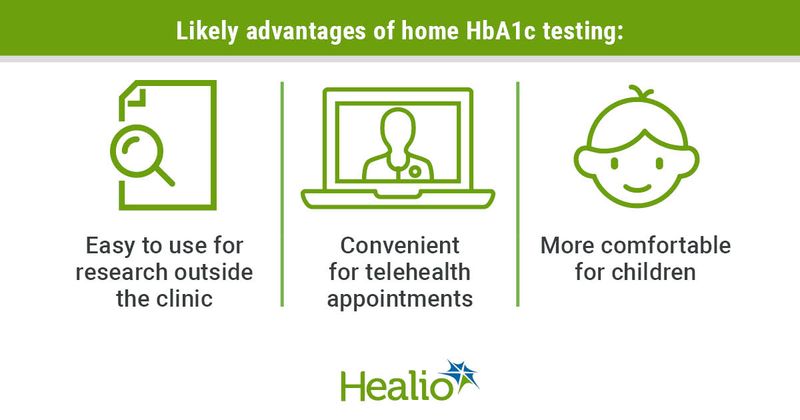Home-use HbA1c kits could aid virtual diabetes care
Capillary blood collection kits, suitable for home use, were shown to be easy to use and provided HbA1c measurements that are comparable to those obtained from venous specimens in the clinic, study data show.

“The take-home message is that with the two test kits used in the study, the accuracy of measuring HbA1c from a finger-stick blood sample is equal to that of a venous blood draw,” Roy W. Beck, MD, PhD, president and medical director of the Jaeb Center for Health Research Foundation Inc., told Healio. “This has considerable relevance for research studies that are either planned to be done outside of clinics or when in-person clinic visits are being replaced by virtual visits, and for being able to avoid a venipuncture blood draw in children.”

Beck and colleagues analyzed data from 240 children and adults from diabetes centers located in Florida, Georgia, Idaho and Missouri (mean age, 28 years; 48% female; 82% white; 85% with type 1 diabetes). Capillary blood samples were obtained by the participant or parent using collection kits from two laboratories — University of Minnesota Advanced Research and Diagnostic Laboratory and Children’s Mercy Hospital Laboratory — and mailed under varying shipping conditions via U.S. Postal Service to the laboratories. Researchers compared HbA1c measurements from capillary samples and contemporaneously obtained venous samples. Primary outcome was percentage of capillary HbA1c values within 5% of the corresponding venous values.
Within the cohort, HbA1c measurements ranged from 5.1% to 13.5%.
Researchers found that HbA1c values were within 5% of venous values for 96% of the Advanced Research and Diagnostic Laboratory kit specimens shipped with a cold pack and 98% without a cold pack, and 99% and 99%, respectively, for the Children’s Mercy Hospital Laboratory kits. Coefficient of determination (R2) values were 0.98, 0.99, 0.99, and 0.99, respectively.
Results appeared similar across HbA1c levels and for pediatric and adult participants. Usability survey scores were high. The findings were published in Diabetes Technology & Therapeutics.
“The accuracy using this method is comparable to measuring HbA1c from a venous blood draw,” Beck told Healio. “The impetus for doing this study was to have validated data to support using home HbA1c measurement in research studies, which became particularly important during the COVID-19 pandemic, when office visits have been limited and telemedicine became a key focus of care of people with diabetes. The ability to accurately measure HbA1c from a finger stick also has substantial importance for young children with diabetes by avoiding a venous blood draw, which can be painful and challenging.”
Beck said, at this time, the two test kits are available only for research studies.
“However, one of them might become commercially available for patients outside of studies in the future,” Beck said. “It is important to recognize that the results of the study apply to these two specific methods and should not be generalized to any other testing methods. We also tested three commercial home tests or kits for HbA1c: Home Access, CoreMedica and A1cNow. We will be reporting on them at the American Diabetes Association Scientific Sessions in June.”
For more information:
Roy W. Beck, MD, PhD, can be reached at rbeck@jaeb.org.

